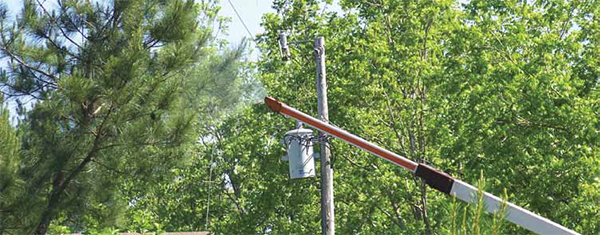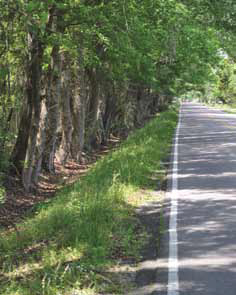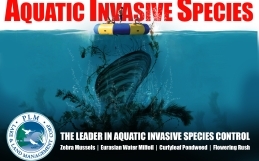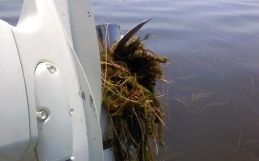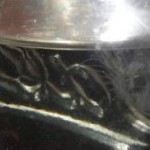Unwanted trees can provide endless challenges to vegetation managers trying to provide reliable power to customers by keeping vegetation cleared back from power lines and rights of way, or keep public or private roadside areas clear and visible.
There are options when it comes to maintenance of these encroaching trees: cut the tree down; mechanically side trim the tree; or use herbicides to either control the entire tree or partially control growth (chemical side trimming). Mechanical cutting can be dangerous, timeconsuming and expensive work, making the use of herbicides a good alternative in many situations. Using a herbicide to chemically side trim a tree allows vegetation managers the ability to control only the part of the tree that is presenting hazards to nearby power lines or roadside access, motorist safety or visibility — while keeping the desirable part of the tree alive and healthy. When used correctly, certain herbicides have demonstrated their ability to effectively “prune back” the treated limbs and not control the tree entirely.
Side Trimming Utility Rights-of-Way
For Helena Chemical Company, based in Collierville, Tenn., chemical side trimming is a great fit for maintaining clear and accessible utility rights-of-way. Helena is a leading distributor and applier of herbicides in the vegetation management market. According to Geer DuBose, vegetation management branch manager with Helena, the company focuses efforts on two types of chemical side trim applications: foliar treatments and dormant stem treatments. “We’ve seen great success with both treatments,” DuBose says. “Our foliar treatment consists of Milestone specialty herbicide at 7 to 10 ounces combined with Krenite herbicide at 2 to 4 percent in 100 gallons of water plus a drift control agent. Our dormant stem treatments use one of two mixes. One is a combination of Milestone and
Garlon 4 Ultra specialty herbicide, and the other combines Milestone and Trycera™ herbicide. Both of these mixes include a high-quality 3 percent v/v oil to ensure good penetration.”
One Helena customer who has seen impressive results from chemical side trimming is the Georgia Electric Membership Corp. In the last four years, Helena has done a lot of chemical side trim work for its members using the Milestone® specialty herbicide and Krenite mix. “There have been fabulous results so far — the treatments are holding back the vegetation very well,” DuBose says. “We are seeing maintenance cycles extended by three to four years over mechanical treatments, and the treatments were initially less expensive, as well.”
Addressing Challenges
But for many utilities, it’s still hard to move away from traditional mechanical treatments. DuBose cites two main reasons for this: worries about customer reaction to vegetation brownout and perceived costs associated. “One challenge associated with chemical side trimming is the visible brownout,” DuBose says. “But if you are willing to accept that it’s going to happen, as well as be proactive in explaining the benefits of this type of application to customers or the public, you can mitigate most issues. At the same time, you have to be extra careful in residential areas, and in some cases, use mechanical treatments when treating areas like subdivision entrances.”
To address the issue of perceived costs, and to demonstrate the cost-effectiveness of chemical side trimming over purely mechanical treatments, Helena has developed a cost calculator. “When you walk into a utility and tell them that chemical side trimming will cost 20 percent less than their current mechanical treatments, the first reaction I normally get is: That’s not a high enough number to make me switch,” DuBose says. “But when I crunch the numbers using our calculator, and then show them all the cost benefits, including the saving associated with extending their treatment cycles — that gets their attention.” Chemical side trimming just provides longer lasting results than mechanical trimming alone. Adding an extra dimension to its side trimming capabilities, Helena has developed a patentpending delivery system to help its applicators treat tall vegetation with much better accuracy and less chance of off-target damage as a result of spray drift. The delivery system is able to be mounted to a variety of vehicles, and includes a telescopic arm that is capable of extending 40 to 60 feet in the air and is outfitted with spray nozzles. The nozzles are interchangeable from fan to cone, depending on the application. “Our system allows us to apply side trim treatments on very tall vegetation with precision and accuracy, with less spray drift and less waste in terms of herbicide solution,” DuBose says. “The generally accepted method of treating branches that high was to simply shoot the spray up there from the ground. But that method can require applicators to use much more herbicide solution in terms of volume sprayed, create opportunity for spray drift and expose applicators to falling spray solution.”
Applications in Roadsides
The South Carolina Department of Transportation is another organization committed to chemical side trimming. It uses chemical side trimming to control the growth of roadside limbs, in most cases after a mechanical treatment. According to Jennifer Gruber, district vegetation manager for South Carolina DOT’s District Six, its chemical side trimming treatments have been a great success, resulting in much longer periods of limb suppression over mechanical trimming alone, thereby greatly reducing the need for mechanical trimming. “We have had very good success with our chemical limb trimming program,” Gruber says. “Our goal is to use herbicide applications to suppress roadside limbs once they have been mechanically trimmed back to the right-of-way or treeline, and only using mechanical means when control can’t be achieved with herbicide.” For the South Carolina DOT, chemical side trimming offers a variety of other benefits, as well. “It’s more economical than mechanical limb trimming due to the amount of equipment, personnel, traffic control and increased liability potential,” Gruber says. “Also, a herbicide application minimally impacts traffic since it’s a moving operation, which normally doesn’t require any lane closures. Our typical mechanical operation consists of a tractor with a boom-mounted rotary saw, two tractors with boom-mounted mowers for debris mulching or a chipper, and all the equipment and personnel required to close a lane and flag traffic. The herbicide application operation typically consists of one truck mounted with a herbicide injection unit.” SCDOT likes using a dormant stem treatment to help avoid leaf brownout. For this treatment, it uses a broadcast spray of Garlon® 4 Ultra
specialty herbicide at a rate of 1 gallon per acre, plus a pint of crop oil to increase penetration and an anti-drift adjuvant.
“Herbicide application is less intrusive than mechanical means and is also more selective of the vegetation that is impacted by the operation,” Gruber adds. “Our procedure for mechanically pruning the right-of-way often disturbs and impacts most of the vegetation in the area.”
A Plan for Continued Success
Much like Helena Chemical, SCDOT has been challenged with educating the public about its herbicide applications, including its innovative chemical side trim applications. “Although perceptions are gradually beginning to change, many times when the public sees SCDOT applying herbicide, they assume there are adverse environmental and personal effects associated,” Gruber says. “In reality, the herbicides we use are very low-toxicity formulations, which degrade very rapidly in the environment. We also utilize very conservative rates in our herbicide program and always use an anti-drift adjuvant.” In addition, all SCDOT herbicide applicators hold Non-Commercial Pesticide Applicator’s Licenses with Category 6 (Right-of-Way) endorsements, and attend annual pesticide applicator refresher training.
“Our goal is to make herbicide applications to control limbs on a two- to three-year cycle,” Gruber says. “But we also will continue evaluating our routes before and after herbicide applications and keep thorough records to improve our program’s effectiveness and minimize adverse impacts to the environment.”
®Trademark of Dow AgroSciences LLC
When treating areas in and around roadside or utility rights-of-way that are or will be grazed, hayed or planted to forage, important label precautions apply regarding harvesting hay from treated sites, using manure from animals grazing on treated areas or rotating the treated area to sensitive crops. See the product label for details. State restrictions on the sale and use of Garlon 4 Ultra and Milestone apply. Consult the label before purchase or use for full details. Always read and follow label directions.
